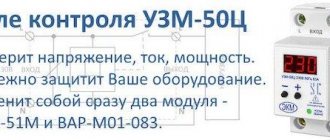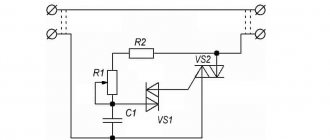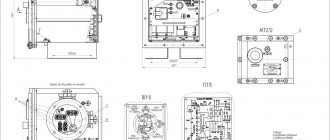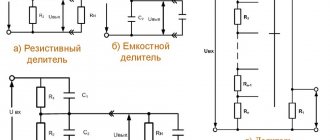Electrical energy is an integral component of the life of modern people, no matter where they live - in the city or in the countryside. It is difficult to imagine an apartment or house where there is not a single household appliance, and candles or torches are used for lighting. However, all household appliances, like lighting elements, which are powered through the home line, are at risk due to voltage instability. Exceeding the permissible limits by this indicator leads to serious problems, including breakdown of expensive equipment and line failure. 220V surge protection for the home will help protect wiring and devices. In this material we will talk about how to protect equipment with your own hands from power surges in an apartment or in a private house.
What are the causes of voltage drops in the network?
The electricity supply system in our state is far from perfect. Because of this, the required voltage value of 220V, for which all household appliances are manufactured, is not always maintained. Depending on the load on the network at a particular moment, the voltage in it can fluctuate within significant limits.
Voltage surges in our networks are not uncommon due to the fact that the vast majority of all elements of the energy supply system were developed several decades ago and were not designed for modern loads. After all, in almost any modern apartment there are many household energy consumers. Of course, this makes living more comfortable, but at the same time it significantly increases electricity consumption. The line cannot always cope with such loads, which results in frequent voltage drops.
One way to protect against network overvoltage on video:
There is no point in hoping that the old system will soon be completely redesigned to meet modern requirements. Therefore, protecting the power line and devices connected to it from power surges is a task in which owners have to think with their own heads and work with their own hands.
Now let's talk about the reasons why power surges occur in more detail. Typically, changes in potential difference occur without sudden surges, and modern equipment, designed to operate in the range from 198 to 242V, is able to cope with them without damage.
We will talk about those cases when the voltage increases significantly within a fraction of a second, and then decreases just as quickly. This is the phenomenon called a power surge. Here are the reasons why it most often occurs:
- Simultaneous turning on (or, conversely, turning off) several devices.
- Break of the neutral conductor.
- Lightning strikes a power line.
- Broken wire inside the wire due to a tree falling on the power line
- Incorrect connection of cables in the common electrical panel.
As you can see, a power surge can occur for various reasons. It is simply unrealistic to predict when it will happen, which means you should think about protection against voltage surges in advance.
An example of installing a voltage relay in the video:
Barrier Lux 63a
4. Demand: I buy cable and wire products from storage and any new ones: whole drums,
I buy cable and wire products from storage and any new ones: whole drums, coils, illiquid stock, remnants on drums.
Large wholesale. Payment in cash, non-cash. Our export from any region of Russia and Kazakhstan! (VVG, AVVG, VBBSHV, AVBBSHV, AABL, AASHV, ASB, KG, KG-HL, KGESH, SB, S BG, SBSHV, KVVG, Sip, NRG, MKShV, GERDA CABLE, TPPEP, SOBBIT, etc.) ( Attention scrappers!. Next" Latest announcements 1. Demand: I buy cables and wires products from storage and any new ones: whole drums,
I buy cables and wires products from storage and new ones of any kind: whole drums, coils, surplus goods, residues on drums. Large wholesale . Payment in cash, non-cash. Our export from any region of Russia and Kazakhstan! (VVG, AVVG, VBBSHV, AVBBSHV, AABL, AASHV, ASB, KG, KG-HL, KGESH, SB, S BG, SBSHV, KVVG, Sip , NRG, MKSHV, GERDA CABLE, TPPEP, SOBBIT, etc. (Attention for scrappers! . Next"
24 Dec 2021 marketur 500
Share this post
- Related Posts
- If the land is leased, is it possible to sell the house?
- In what case, when changing the checkpoint, is it necessary to conclude an additional agreement to the service agreement?
- How can a pensioner receive compensation for the purchase of household appliances?
- Income tax benefit for children in the Republic of Belarus
How to protect equipment from overvoltage?
Of course, the best option for protecting the home network and the devices included in it from high voltage is a complete reconstruction of the power supply system, followed by its subsequent maintenance by experienced specialists. But while it is still possible to completely replace the wiring in a private house, in multi-apartment buildings this is unrealistic. Practice shows that several dozen residents will almost never be able to agree on joint payment for such work.
It is unlikely that management companies will do this either. But it is useless to change the electrical wiring in a separate apartment - voltage surges will not go away, since they usually arise due to common equipment.
What can you do to prevent power surges from causing serious damage? Shouldn’t we wait until the utility workers and all the neighbors in the house have a desire to replace the general electrical wiring in the building? There is only one answer - choose a reliable device to protect your home network from power surges.
Today, the following devices are used to increase the safety of home equipment and to minimize the likelihood of damage due to overvoltage:
- Voltage control relay (VCR).
- Overvoltage sensor (OHS).
- Stabilizer.
Separately, uninterruptible power supplies should be mentioned. They are close to the listed devices, but they cannot be called full-fledged devices for protecting lines from potential differences. We will talk about them in more detail below.
Voltage control relay
When power surges in an apartment occur infrequently and there is no need for constant protection from them, it is enough to connect a special relay to the network.
What is this element? RKN is a small device whose task is to turn off the circuit during a potential difference and restore the supply of electricity after the network parameters return to normal. The relay itself does not affect the magnitude and stability of the voltage in any way, but only records the data. These devices come in two types:
- A common unit, which is installed in the distribution panel and protects the entire apartment from overvoltage.
- A device that in appearance resembles an extension cord with electrical sockets into which individual devices are connected.
Visually pen the principle of operation of the voltage relay in the video:
When purchasing a relay, it is important not to make a mistake in calculating its power. It should slightly exceed the total power of the devices connected to the device. Individual RKNs that are included in the general network are not difficult to select - you just need to buy an element with the required number of sockets.
These devices are convenient and inexpensive, but they only make sense to use when the network is stable. If power surges occur constantly in it, this option will not work - after all, few owners will like the continuous switching on and off of the entire network or individual devices.
Barrier Functions
In short, a Barrier is a circuit breaker that constantly monitors the input voltage in the network. As soon as the voltage goes beyond the permissible limits (which are set by the user), the relay turns off the consumer. Therefore, it is also called surge protection relay, voltage barrier, or surge protector.
We can say that the Barrier is protection against overvoltage in the network.
In normal mode, this relay passes the entire load current through itself, and at the same time serves as a digital indicator of the voltage level. Agree, this is also convenient.
Communities › Electronic Crafts › Blog › Temporary question regarding electrical wiring and protection
It is also recommended to install a voltage stabilizer for a double-circuit gas boiler. I don’t consider a UPS because over the last 5 years the voltage has been turned off a couple of times for a couple of hours. I’m wondering whether it’s worth installing it for the stabilizer or whether a UZM with a UZP will be enough. Your opinion and advice The UZM fire protection multifunctional device is designed to turn off equipment when an emergency electric arc (sparking) is detected in the electrical wiring, as well as in case of a dangerous decrease or increase in mains voltage in single-phase networks. Protects equipment connected to it (in an apartment, office, etc.) from the destructive effects of pulsed voltage surges caused by the operation of nearby electric motors, magnetic starters or electromagnets connected to the same network, thereby preventing equipment failure and possible ignition with subsequent fire .
Please note => Petrovich St. Petersburg return of goods
Photo from outside
Here's what I got my hands on:
Barriers – digital network surge protection relays
Why I needed so many Barriers (and that’s only half!) – I’ll tell you in the next article. Don't forget to subscribe to receive it immediately by email.
Barriers are much cheaper than their Ukrainian competitors Digitop, I still don’t understand why, and the sellers couldn’t answer clearly. At the time of purchase (Russia, Taganrog, October 2015), such devices cost 1,800 rubles, while Digitop in the same store cost almost 3,000 rubles.
Barrier packaging. It describes in detail what it is, what it is for, and how it works.
Voltage control relay Barrier in Yekaterinburg
Voltage relay RESANTA AZM-40A
Voltage control relay serial. 220-380V, 230-400V 2PK type RNPP-311M
Monitoring relay 1 phase voltage (65. 260V high and low, shutter speed 0.1. 10 sec) 1pc
RBUZ Voltage relay D63t
(ZUBR) RBUZ D63t - single-phase voltage control relay for DIN rail. Protection against overvoltage, dips and surges in the network. Overvoltage limiter surge arrester.
Voltage monitoring relay CM-PVE (monitoring 1/3-phase Umin/max LN 185-265V AC) 1NO
Voltage monitoring relay Digitop Vp-63A
Voltage relay DIGITOP V-protector Vp-40A DIN
Voltage control relay Albatros RNT-63A
(ZUBR) RBUZ R116y - single-phase voltage control relay for home socket. Protection against overvoltage, dips and surges in the network. Surge arrester - surge suppressor.(
ASP-1MCV Voltage relay - single-phase network control complete with power relay
Voltage control relay RBUZ SR1 (in socket)
RBUZ Voltage relay D63t
Voltage relay DIGITOP V-protector Vp-32A DIN
Liquid level control relay Orbis EBR-1
Voltage control relay phase failure 3x320-460V, 185-265V 1 but CM-PVE
Voltage relay with current control DigiTOP VA-40(A), 8.8 kW, on DIN
Voltage relay Digitop Vp-20a
Voltage relay (parallel connection) RV-5A EKF PROxima
Voltage monitoring relay Digitop Vp-16 AS
Modular voltage control relay 160-280V 1PK 32A type RN-113
Voltage relay DigiTOP Vp-3F40A, color: white, 12.5 x 9 cm
DigiTOP V-protector 10AS - single-phase voltage control relay for home socket. Protection against overvoltage, dips and surges in the network. Surge arrester - surge suppressor.
(ZUBR) RBUZ 3F — Three-phase voltage control relay for DIN rail. Protection against overvoltage, dips and surges in the network. Surge arrester - surge suppressor.(
Source
Photo inside - power section
We unscrew the 4 screws, and this is what we see:
Power board. Through the brown wire, zero goes to power the circuit.
This is a board on which the power supply circuit of the entire device is assembled, and the most important part is a powerful relay, through the contacts of which all the current in our apartment or office will pass.
Appearance of the Barrier relay board (another copy). The red wire is zero for powering the circuit.
The wires from the contacts to the relay are made very reliably. A piece of copper is clamped into the screw terminals, to which a flexible wire with a cross-section of at least 6 mm² is welded. And this wire is securely welded to the relay contacts. This can be seen better in the following photo:
Power relay contacts
To the right of the relay we see a key transistor that powers the relay coil, a 1000 uF filter capacitor for the power supply, and a heat-shrinkable capacitor for the relay switching circuit (more details below).
The white wires are where the relay coil is powered.
Since this is a very important element, let's look at it in more detail. Here's a closer look at the relay:
Power relay NRL-08B-12D
Remove the cover with 4 latches:
Lid. Just a cover.
And we see the contacts of this relay. Usually the contacts are made changeover (switching), here there is no point in this, the contact is simply a short-circuit or open circuit:
Internals of relay NRL08B-12D
The relay is not quite ordinary (bistable), since it has two stable states. Another name is a latch relay.
That is, energy is spent only on switching the relay, but no voltage needs to be applied to hold the contacts. In this case, the relay coil naturally does not heat up.
Another name for such a relay is a pulse relay. I write about such a relay in the article Pulse relay with a staircase machine.
The relay contact current is 80 A. It is worth saying that the 60 A Barrier also has an 80 A relay. Therefore, they are absolutely no different. Also with lower ratings - in the 40 and 32 A Barriers there are 40 A relays, in the 16 A Barrier there is a 25 A relay. It is commendable that the manufacturer (Donetsk) indicates the parameters of its device with a margin.
Now let's see what's on the back of the power board:
Solder side board
On the right is the power supply, closer to the center are transistors with wiring that ensure the operation of the bistable relay. Powerful transistor – from the “parts” side, shown in the photographs earlier.
On the left (it turns out, under the screw terminals) are 4 diodes connected in series. They work as a temperature sensor - when the terminals heat up (too much current, or the tightening is loose), the diodes through the board also heat up, the current through them increases, the voltage from the diodes goes to the corresponding input of the controller, and it generates an error. For more details, see the Barrier instructions, which are given at the end of the article.
Instructions for the Barrier voltage relay
Barrier voltage relay instructions for use and operation, page 1
Barrier voltage relay instructions for use and operation, page 2
Instructions for use in text form:
1. PURPOSE OF THE PROTECTION DEVICE The protection device (BARRIER) measures the voltage in the 220V 50Hz AC network and disconnects electrical appliances from this network in cases where the network voltage becomes higher or lower than the values set by the manufacturer or user and remains disconnected from the network until restored voltage at specified values. Thus, it protects electrical appliances connected after it from being left standing. After a time specified by the manufacturer or the user, when the voltage in the network normalizes, the electrical appliances will be connected again to the network. In the mode when the protected electrical appliances are disconnected from the network, the numbers on the indicator of the protection device blink. The device is controlled by a microcontroller that measures, analyzes and displays the current effective voltage value in the electrical network. Load switching is carried out by an electromagnetic relay. Permissible shutdown limits and turn-on time delay are set by the user using buttons. The values are stored in non-volatile memory. The device is mounted on a DIN rail.
2. TECHNICAL DATA Operating voltage range of the device, V, 120-400 Maximum switching power.
BARRIER-16A kW 3.5 BARRIER-30A kW 6.5 BARRIER-40A kW 8.5 BARRIER-60A kW 13 BARRIER-80A kW 17.5 Shutdown time at the upper limit, sec 0.2 at the lower limit, sec 1 (120-190V) Upper voltage adjustment range actuation, V from 210 to 270 Adjustment range of lower actuation voltage, V from 120 to 190 Voltage supply delay time, sec from 10 to 390 (from 0.1 min. to 6.5 min.) Power consumption by the device, W 1 Dimensions. mm 90x53x67
3. OPERATION PROCEDURE
Connect the BARRIER to the network according to the connection diagram, set the automatic switches to the ON position. The voltmeter will show the voltage in the network and will blink (blinking means that there is no voltage at the device output). If the voltage in the network is within normal limits, the protection device will connect the electrical appliance to the network after a time specified in it and the voltmeter will stop flashing. To change the lower shutdown level, press and hold the “down” button until the indicator goes out, release the button, the indicator will display the previously set value. If it needs to be changed, then within 10 seconds you need to press the “down” button again and hold it again until the indicator goes out, then release the button, the device will go into the value setting mode (the last digit will start flashing). Using the “up” and “down” buttons you can change this value within the range of 120 -190 Volts. To change the upper shutdown limit, press and hold the “up” button until the indicator goes out, release the button, the indicator will display the previously set value. If it needs to be changed, then within 10 seconds you need to press the “up” button again and hold it again until the indicator goes out, then release the button, the device will go into the value setting mode (the last digit will start flashing). Using the “up” and “down” buttons you can change this value within the range of 210 - 270 Volts. To change the on time, press and hold both the “up” and “down” buttons simultaneously until the indicator goes out, release the buttons, the previously set value will appear on the indicator. If it needs to be changed, then within 10 seconds you need to press both buttons again and hold again until the indicator goes out, then release the buttons, the device will go into the value setting mode (the last symbol of the indicator will start flashing). Using the “up” and “down” buttons you can change this value within the range from 01s (which corresponds to 10 seconds) to 39s (which corresponds to 390 seconds or 6.5 minutes). The device exits the settings mode automatically 10 seconds after the last button press.
Barrier luxury 01/16-63 150-280v/16-63A
Description and principle of operation
Barrier Lux 63A has four adjustable voltage protection thresholds: “Maximum”, “Maximum peak”, “Minimum”, “Minimum peak” ( Adjustable range 150 - 280 Volts).
Suppose you set the “Maximum voltage” to 240 Volts, and the “Maximum peak” to 275 Volts. Voltage surges within 240 - 275 Volts for up to 1 second. will not trigger the device, which allows you to avoid frequent emergency shutdowns of houses from electricity due to impulse noise in the network. If the voltage exceeds 275 Volts, the device will instantly (0.02 sec.) disconnect your home from dangerous electricity and automatically resume its supply only after returning to safe parameters. The “Minimum Peak” voltage is adjusted in the same way, where the “Minimum” is set slightly higher than the “Minimum Peak” voltage. Barrier Lux device has 7 current protection thresholds (16, 20, 25, 32, 40, 50, 63 Amperes) , which allows the product to be used in rooms with electrical wiring power from 3.5 to 12 kW/h. If you use additional electrical appliances (welding machines, electric furnaces, electric heating devices, etc.), it is possible to independently increase the current protection parameters (let’s say from 25 to 40 Amps) without changing this product to similar, more powerful devices. Also, on the contrary, if you want to limit electricity consumption to a level that is safe for wiring or economical, it is enough to lower the power protection limit.
Description
The circuit breaker is designed to automatically turn off any network equipment, the total power of which is not * kilowatt, if the voltage in the electrical network exceeds the upper shutdown limit specified in the device settings, or drops below the specified lower shutdown limit and automatically turns on if the voltage is restored and is within the permitted range . The circuit breaker is also designed to indicate the current average rectified value of the mains voltage.
The device is a switch controlled by a microprocessor, which analyzes the voltage in the electrical network and if it exceeds or is less than a predetermined one, it issues a signal to turn off the load. If the voltage returns to normal (within the specified limits), after a delay, the value of which is set when setting up the device, a signal is issued to turn on the load. Load switching is carried out by an electromagnetic relay. The microprocessor also controls the operation of the voltmeter.
Area of application of the device: protection of houses, apartments, powerful technological equipment.
Specifications:
Permissible long-term voltage at the device terminal block 0 - 400 Volts Switching current 60 A
Load power no more than 13000 Watts Switch-off time at the upper limit 0.2 seconds Switch-off time at the lower limit * no more than 1 second Operating voltage range of the device 120 - 400 Volts Overall dimensions 3 modules of type S Mounting on a standard 35 mm DIN rail
The Barrier voltage relay has a warning function about poor contact of wires to the terminals! If during operation of the device the protected electrical appliances turn off and three squares appear on the indicator, this means that due to poor contact, heating has occurred at the place where the wires are connected to the terminals.
* With a short-term, no more than 1 second, drop to 120 Volts, regardless of the set lower threshold, the load does not turn off. In this way, inrush currents are ignored (so-called welding protection). If the voltage is below the lower set value for more than 1 second, a shutdown occurs. If the voltage drops below 120 volts, shutdown occurs in 0.2 seconds.
User Defined Parameters
Lower shutdown limit (resolution 1 Volt) 120 - 190 Volt Upper shutdown limit (resolution 1 Volt) 210 - 270 Volt Load turn-on delay time (resolution 5 seconds) 10 - 390 sec.
Delivery contents: device - 1 piece; instruction manual – 1 piece; packaging (cardboard box) – 1 pc.











